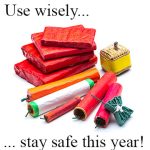Declare Independence from Hand Injuries this 4th of July
Fireworks are a “blast,” but they can be hazardous too. Every year, fireworks cause thousands of injuries and emergency room visits. Did you know that hands and fingers are the most likely body parts to get injured? Let’s ensure your hands stay safe this 4th of July with these easy-to-follow guidelines for using legal fireworks in your area.
Keep Kids Safe
Sparklers are synonymous with Fourth of July parties. Kids love running around with them and they might seem safe, but they burn at about 2,000 degrees Fahrenheit—hot enough to cause blast injuries that could result in severe burns and amputation. Sparklers alone account for more than 25 percent of emergency room visits for fireworks injuries, and half of those injuries involve children under 5 years old. Consider safer alternatives like glow sticks, confetti poppers, or colored streamers for young children.
Stay Sober
Never use fireworks while impaired by drugs or alcohol. Stay alert and in control to keep everyone safe. Impairment slows your reaction time and affects your judgment, which can lead to serious accidents and injuries, including broken bones or severe hand trauma.
Wear Protective Eyewear
Everyone using fireworks or standing nearby should wear protective eyewear to shield their eyes from sparks and debris. This simple precaution can prevent serious eye injuries. Even spectators can be at risk from stray sparks and exploding fragments, which can lead to eye trauma requiring surgical intervention.
Never Hold Lighted Fireworks in Your Hands
Always place fireworks on the ground or in a safe holder before lighting them. This prevents burns and severe injuries to your hands, such as fractures or amputations. Holding fireworks increases the risk of severe hand injuries, including the loss of fingers.
Maintain a Safe Distance
Use fireworks away from people, houses, and flammable materials. Keep a safe distance after lighting to avoid accidents. Being too close to lit fireworks increases the risk of burns, injuries from explosions, and potential bone fractures from blast force.
Light One Device at a Time
Only light one firework at a time and move away quickly after lighting. This ensures better control and safety, preventing multiple devices from igniting at once and causing multiple injuries.
Avoid Containers
Never ignite fireworks in a container, as they can explode and cause severe injuries. Containers can act like bombs, intensifying the explosion and sending dangerous shrapnel flying.
Don’t Re-Light Malfunctioning Fireworks
If a firework doesn’t go off, don’t try to relight or handle it. Wait 20 minutes, then soak it in water before disposing of it. Malfunctioning fireworks can still be live and might explode unexpectedly if handled.
Soak Spent Fireworks
Soak both spent and unused fireworks in water for a few hours before discarding them to ensure they don’t reignite. Always have a bucket of water or a hose ready to extinguish fireworks that don’t go off or in case of a fire. This ensures all fireworks are safely neutralized and prevents accidental fires from smoldering remnants, which could cause further injury.
Avoid Illegal Fireworks
Never use illegal fireworks. They are often more dangerous and less reliable. Legal fireworks are tested for safety and compliance, while illegal ones may not meet safety standards and are more likely to malfunction. Professional displays are conducted with strict safety protocols and are far more impressive than consumer fireworks, so let the experts handle the big shows.
Fireworks are fun and a great way to celebrate Independence Day, but keeping your hands and fingers safe is important. Prioritize safety by following these tips, and make sure to pass them along to friends and family as well. Let’s ensure everyone has a blast—safely! Protect your hands, because they’re essential for all the other fun activities you enjoy.



